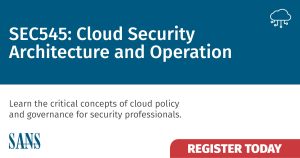
One of today’s most rapidly evolving and widely deployed technologies is server virtualization. SEC579: Virtualization and Software-Defined Security is intended to help security, IT operations, and audit and compliance professionals build, defend, and properly assess both virtual and converged infrastructures, as well as understand software-defined networking and infrastructure security risks. Many organizations are already realizing cost savings from implementing virtualized servers, and systems administrators love the ease of deployment and management of virtualized systems. More and more organizations are deploying desktop, application, and network virtualization as well. There are even security benefits of virtualization: easier business continuity and disaster recovery, single points of control over multiple systems, role-based access, and additional auditing and logging capabilities for large infrastructure. With these benefits comes a dark side, however. Virtualization technology is the focus of many new potential threats and exploits, and it presents new vulnerabilities that must be managed. There are also a vast number of configuration options that security and system administrators need to understand, with an added layer of complexity that has to be managed by operations teams. Virtualization technologies also connect to network infrastructure and storage networks, and require careful planning with regard to access controls, user permissions, and traditional security controls. In addition, many organizations are evolving virtualized infrastructure into private clouds using converged infrastructure that employs software-defined tools and programmable stack layers to control large, complex data centers. Security architecture, policies, and processes will need to be adapted to work within a converged infrastructure, and there are many changes that security and operations teams will need to accommodate to ensure that assets are protected.
Syllabus
SEC579.1: Core Concepts of Virtualization Security
SEC579.2: Virtualization and Software-Defined Security Architecture and Design
SEC579.3: Virtualization Threats, Vulnerabilities, and Attacks
SEC579.4: Defending Virtualization and Software-Defined Technologies
SEC579.5: Virtualization Operations, Auditing, and Monitoring






